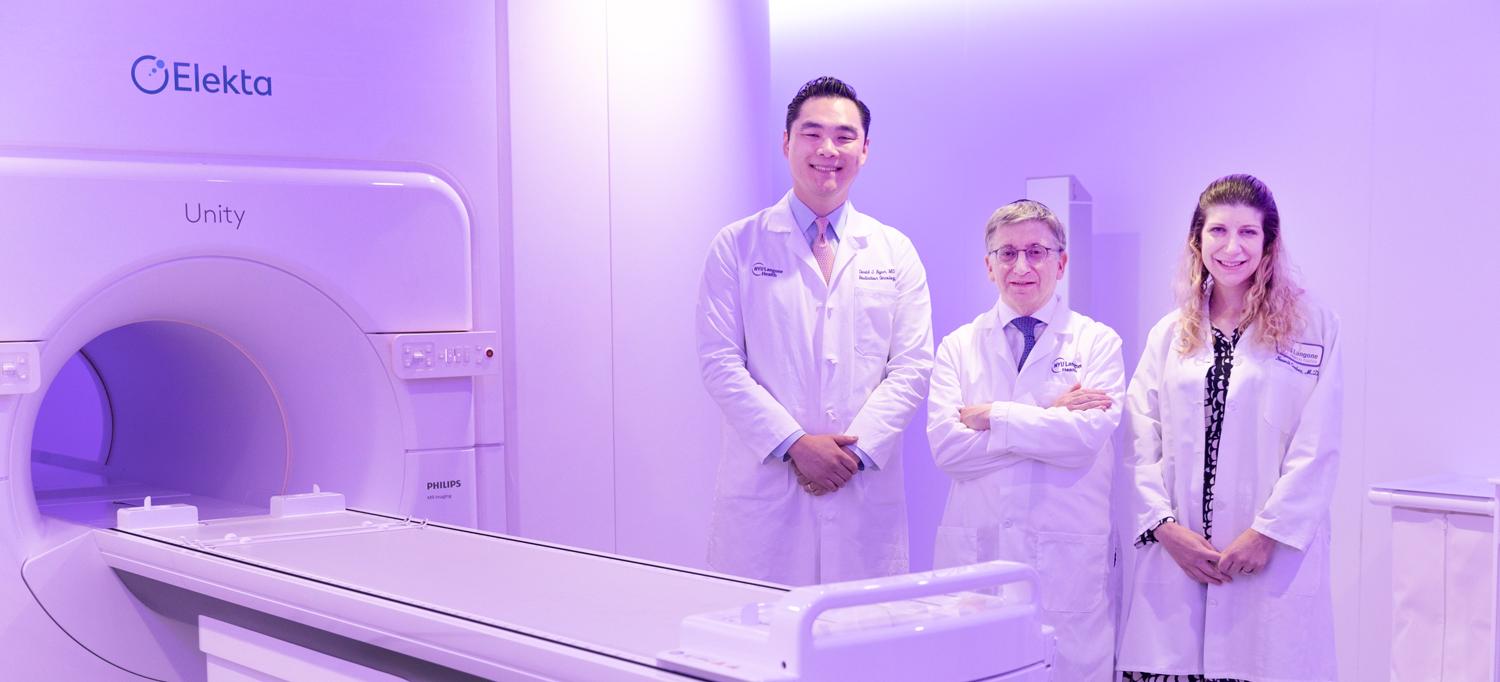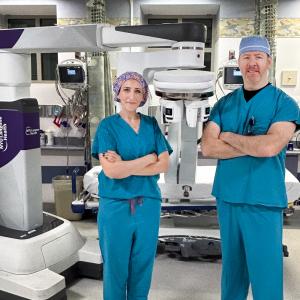
Radiation oncologists Dr. David Byun, Dr. Michael Zelefsky, and Dr. Naamit Gerber stand next to the MR-LINAC machine, which provides precise radiation therapy for prostate cancer.
Credit: Haley Ricciardi
Stuart Dryburgh, now 72, had a tough decision to make last summer. Routine tests at NYU Langone Ambulatory Care Brooklyn Heights revealed elevated prostate-specific antigen (PSA) levels. His primary care physician, Anne Crenesse, MD, a clinical assistant professor of medicine at NYU Grossman School of Medicine, referred him for a biopsy. The results indicated that the Oscar-nominated cinematographer had early-stage prostate cancer.
Like many men in his position, Dryburgh had a variety of treatment options but no clear path. He could choose active surveillance, with periodic tests to assess whether the cancer was advancing. Dryburgh preferred a more proactive course, but he was averse to the most extreme option—the removal of his entire prostate gland, known as a radical prostatectomy—because he was concerned about potential side effects, such as erectile dysfunction and urinary incontinence. Ultimately, he was referred to radiation oncologist David J. Byun, MD, an assistant professor in the Department of Radiation Oncology, to learn about targeted radiation therapy, which Dryburgh saw as a more comfortable middle-ground treatment option.
During his consultation with Dr. Byun, Dryburgh heard about a groundbreaking technique that seemed like a perfect fit for him: precise doses of radiation delivered by a magnetic resonance imaging–guided linear accelerator, also known as MR-LINAC. The noninvasive approach combines high-resolution imaging that allows doctors to see the prostate gland and surrounding tissue in unprecedented detail with a photon linear accelerator that precisely directs high-intensity radiation beams at cancerous cells while sparing healthy surrounding tissue. “So they’re hitting the things they want to hit and avoiding the things they want to avoid,” Dryburgh says.
The MR-LINAC machine, which arrived last spring at NYU Langone Health, uses a huge magnet that had to be delivered through a shaft accessible from the sidewalk along First Avenue, adjacent to the Manhattan campus. Workers then reassembled the machine in a specially designed suite within the Department of Radiation Oncology. The device, due to its size, cost, and sophistication, is only the second of its kind in the New York metropolitan region.
Dryburgh, who became the first NYU Langone patient treated for prostate cancer with MR-LINAC in August 2023, was drawn to it by the fact that he’d need only five sessions and that the accuracy was unmatched by other radiation methods. “The beam is still being delivered in a similar way to traditional methods, but the image guidance is the differentiator,” explains Dr. Byun. “As clinicians, we can see precisely where the blood vessels and nerves that supply erectile function are, as well as the bladder neck and urethra, both essential for urinary function. So we can better protect those organs.”
Even small anatomical movements, such as the bladder filling with urine, can slightly shift the positioning of the prostate, potentially interfering with targeted radiation treatments. But MRI imaging, combined with motion management tracking, enables adjustments to avoid mistakes. “These technologies take MRI snapshots in real time and make submillimeter adjustments before delivering the treatment,” explains Michael J. Zelefsky, MD, vice chair for academic and faculty affairs in the Department of Radiation Oncology and director of brachytherapy services at NYU Langone’s Perlmutter Cancer Center. “Throughout the seven or eight minutes of actual treatment, it monitors the prostate to ensure that nothing has changed.”
Dryburgh’s treatments, delivered over two weeks, each took under an hour from start to finish, with little discomfort. “It couldn’t have been easier, to be honest,” he says.
At his checkup in November 2023, Dryburgh’s PSA level had returned to normal. Side effects have remained “very mild and manageable,” he reports. With his cancer therapy behind him, he’s free to focus on more enjoyable decisions: those for his latest film project, a romantic comedy called Kinda Pregnant, that is shooting near his home in Brooklyn.
Through January 2024, Perlmutter Cancer Center radiation oncologists had used MR-LINAC to treat more than 50 patients with early- to advanced-stage prostate cancer. Dr. Zelefsky, who joined NYU Langone from Memorial Sloan Kettering Cancer Center last year, and Dr. Byun have launched multiple clinical trials to assess treatment outcomes and side effects for their rapidly growing roster.
The close collaborators are investigating other projects, as well, including how MR-LINAC might be directed at cancers in other sites requiring high-definition imaging and precision. Among the potential targets are tumors of the gastrointestinal tract, pancreas, lungs, spine, and brain. “There’s a great role for expanding this technology and potentially improving the quality of life of patients treated for a variety of tumors,” Dr. Zelefsky says.


